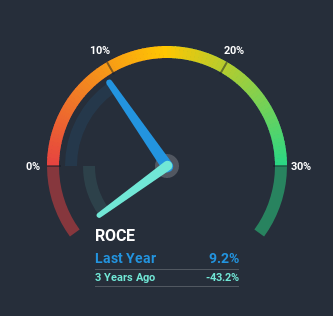- India
- /
- Electrical
- /
- NSEI:SCHNEIDER
Is Schneider Electric Infrastructure (NSE:SCHNEIDER) A Future Multi-bagger?
If you're not sure where to start when looking for the next multi-bagger, there are a few key trends you should keep an eye out for. Firstly, we'll want to see a proven return on capital employed (ROCE) that is increasing, and secondly, an expanding base of capital employed. Basically this means that a company has profitable initiatives that it can continue to reinvest in, which is a trait of a compounding machine. Speaking of which, we noticed some great changes in Schneider Electric Infrastructure's (NSE:SCHNEIDER) returns on capital, so let's have a look.
Understanding Return On Capital Employed (ROCE)
If you haven't worked with ROCE before, it measures the 'return' (pre-tax profit) a company generates from capital employed in its business. Analysts use this formula to calculate it for Schneider Electric Infrastructure:
Return on Capital Employed = Earnings Before Interest and Tax (EBIT) ÷ (Total Assets - Current Liabilities)
0.092 = ₹344m ÷ (₹12b - ₹8.0b) (Based on the trailing twelve months to September 2020).
Thus, Schneider Electric Infrastructure has an ROCE of 9.2%. On its own, that's a low figure but it's around the 9.8% average generated by the Electrical industry.
See our latest analysis for Schneider Electric Infrastructure

Historical performance is a great place to start when researching a stock so above you can see the gauge for Schneider Electric Infrastructure's ROCE against it's prior returns. If you want to delve into the historical earnings, revenue and cash flow of Schneider Electric Infrastructure, check out these free graphs here.
What Does the ROCE Trend For Schneider Electric Infrastructure Tell Us?
Schneider Electric Infrastructure's ROCE growth is quite impressive. The figures show that over the last five years, ROCE has grown 239% whilst employing roughly the same amount of capital. So it's likely that the business is now reaping the full benefits of its past investments, since the capital employed hasn't changed considerably. The company is doing well in that sense, and it's worth investigating what the management team has planned for long term growth prospects.
Another thing to note, Schneider Electric Infrastructure has a high ratio of current liabilities to total assets of 68%. This effectively means that suppliers (or short-term creditors) are funding a large portion of the business, so just be aware that this can introduce some elements of risk. While it's not necessarily a bad thing, it can be beneficial if this ratio is lower.The Bottom Line
In summary, we're delighted to see that Schneider Electric Infrastructure has been able to increase efficiencies and earn higher rates of return on the same amount of capital. And since the stock has fallen 56% over the last five years, there might be an opportunity here. That being the case, research into the company's current valuation metrics and future prospects seems fitting.
While Schneider Electric Infrastructure looks impressive, no company is worth an infinite price. The intrinsic value infographic in our free research report helps visualize whether SCHNEIDER is currently trading for a fair price.
If you want to search for solid companies with great earnings, check out this free list of companies with good balance sheets and impressive returns on equity.
When trading Schneider Electric Infrastructure or any other investment, use the platform considered by many to be the Professional's Gateway to the Worlds Market, Interactive Brokers. You get the lowest-cost* trading on stocks, options, futures, forex, bonds and funds worldwide from a single integrated account. Promoted
New: Manage All Your Stock Portfolios in One Place
We've created the ultimate portfolio companion for stock investors, and it's free.
• Connect an unlimited number of Portfolios and see your total in one currency
• Be alerted to new Warning Signs or Risks via email or mobile
• Track the Fair Value of your stocks
This article by Simply Wall St is general in nature. It does not constitute a recommendation to buy or sell any stock, and does not take account of your objectives, or your financial situation. We aim to bring you long-term focused analysis driven by fundamental data. Note that our analysis may not factor in the latest price-sensitive company announcements or qualitative material. Simply Wall St has no position in any stocks mentioned.
*Interactive Brokers Rated Lowest Cost Broker by StockBrokers.com Annual Online Review 2020
Have feedback on this article? Concerned about the content? Get in touch with us directly. Alternatively, email editorial-team@simplywallst.com.
About NSEI:SCHNEIDER
Schneider Electric Infrastructure
Designs, manufactures, builds, and services products and systems for electricity distribution in India and internationally.
Solid track record with excellent balance sheet.
Similar Companies
Market Insights
Community Narratives



